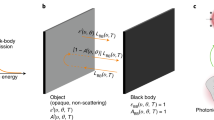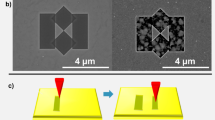Abstract
Wavelength-selective thermal emitters (WS-EMs) are of interest due to the lack of cost-effective, narrow-band sources in the mid- to long-wave infrared. WS-EMs can be realized via Tamm plasmon polaritons (TPPs) supported by distributed Bragg reflectors on metals. However, the design of multiple resonances is challenging as numerous structural parameters must be optimized simultaneously. Here we use stochastic gradient descent to optimize TPP emitters (TPP-EMs) composed of an aperiodic distributed Bragg reflector deposited on doped cadmium oxide (CdO) film, where layer thicknesses and carrier density are inversely designed. The combination of the aperiodic distributed Bragg reflector with the designable plasma frequency of CdO enables multiple TPP-EM modes to be simultaneously designed with arbitrary spectral control not accessible with metal-based TPPs. Using this approach, we experimentally demonstrated and numerically proposed TPP-EMs exhibiting single or multiple emission bands with designable frequencies, line-widths and amplitudes. This thereby enables lithography-free, wafer-scale WS-EMs that are complementary metal–oxide–semiconductor compatible for applications such as free-space communications and gas sensing.
This is a preview of subscription content, access via your institution
Access options
Access Nature and 54 other Nature Portfolio journals
Get Nature+, our best-value online-access subscription
$29.99 / 30 days
cancel any time
Subscribe to this journal
Receive 12 print issues and online access
$259.00 per year
only $21.58 per issue
Buy this article
- Purchase on Springer Link
- Instant access to full article PDF
Prices may be subject to local taxes which are calculated during checkout




Similar content being viewed by others
Data availability
The authors declare that the data supporting the findings of this study are available within the paper and its supplementary information files. Additional data is available from the authors upon request.
Code availability
The algorithms used for this work are available within the paper as well as at our group website (https://my.vanderbilt.edu/caldwellgroup/).
References
Livingood, A. et al. Filterless nondispersive infrared sensing using narrowband infrared emitting metamaterials. ACS Photon. 8, 472–480 (2021).
Lochbaum, A. et al. On-chip narrowband thermal emitter for mid-IR optical gas sensing. ACS Photon. 4, 1371–1380 (2017).
Lochbaum, A. et al. Compact mid-infrared gas sensing enabled by an all-metamaterial design. Nano Lett. 20, 4169–4176 (2020).
Baranov, D. G. et al. Nanophotonic engineering of far-field thermal emitters. Nat. Mater. 18, 920–930 (2019).
Lu, G. et al. Narrowband polaritonic thermal emitters driven by waste heat. ACS Omega 5, 10900–10908 (2020).
Howes, A., Nolen, J. R., Caldwell, J. D. & Valentine, J. Near-unity and narrowband thermal emissivity in balanced dielectric metasurfaces. Adv. Optical Mater. 8, 1901470 (2020).
Kelley, K. P. et al. Multiple epsilon-near-zero resonances in multilayered cadmium oxide: designing metamaterial-like optical properties in monolithic materials. ACS Photon. 6, 1139–1145 (2019).
Schuller, J. A., Taubner, T. & Brongersma, M. L. Optical antenna thermal emitters. Nat. Photon. 3, 658–661 (2009).
Wang, T. et al. Phonon-polaritonic bowtie nanoantennas: controlling infrared thermal radiation at the nanoscale. ACS Photon. 4, 1753–1760 (2017).
Arnold, C. et al. Coherent thermal infrared emission by two-dimensional silicon carbide gratings. Phys. Rev. B 86, 035316 (2012).
Asano, T. et al. Near-infrared–to–visible highly selective thermal emitters based on an intrinsic semiconductor. Sci. Adv. 2, e1600499 (2016).
Kaliteevski, M. et al. Tamm plasmon-polaritons: possible electromagnetic states at the interface of a metal and a dielectric Bragg mirror. Phys. Rev. B 76, 165415 (2007).
Sasin, M. E. et al. Tamm plasmon polaritons: slow and spatially compact light. Appl. Phys. Lett. 92, 251112 (2008).
Sakurai, A. et al. Ultranarrow-band wavelength-selective thermal emission with aperiodic multilayered metamaterials designed by Bayesian optimization. ACS Cent. Sci. 5, 319–326 (2019).
Wang, Z. et al. Ultra-narrow and wavelength-tunable thermal emission in a hybrid metal-optical Tamm state structure. ACS Photon. 7, 1569–1576 (2020).
Wang, Z. et al. Narrowband thermal emission realized through the coupling of cavity and Tamm plasmon resonances. ACS Photon. 5, 2446–2452 (2018).
Yang, Z.-Y. et al. Narrowband wavelength selective thermal emitters by confined tamm plasmon polaritons. ACS Photon. 4, 2212–2219 (2017).
Botros, J., Ali, M. O., Tait, R. N., Amaya, R. E. & Gupta, S. Direct thermal emission testing of aperiodic dielectric stack for narrowband thermal emission at mid-IR. J. Appl. Phys. 127, 114502 (2020).
Nolen, J. R. et al. Ultraviolet to far-infrared dielectric function of n-doped cadmium oxide thin films. Phys. Rev. Mater. 4, 025202 (2020).
Liu, C. P. et al. Effects of free carriers on the optical properties of doped CdO for full-spectrum photovoltaics. Phys. Rev. Appl. 6, 064018 (2016).
Runnerstrom, E. L., Kelley, K. P., Sachet, E., Shelton, C. T. & Maria, J.-P. Epsilon-near-zero modes and surface plasmon resonance in fluorine-doped cadmium oxide thin films. 4, 1885–1892 (2017).
Sachet, E. et al. Dysprosium-doped cadmium oxide as a gateway material for mid-infrared plasmonics. Nat. Mater. 14, 414–420 (2015).
Cleri, A. et al. Mid-wave to near-IR optoelectronic properties and epsilon-near-zero behavior in indium-doped cadmium oxide. Phys. Rev. Mater. 5, 035202 (2021).
Xue, W. & Miller, O. D. High-NA optical edge detection via optimized multilayer films. Preprint at https://arxiv.org/abs/2101.03160 (2021).
Jiang, J. & Fan, J. A. Multiobjective and categorical global optimization of photonic structures based on ResNet generative neural networks. Nanophotonics 10, 361–369 (2021).
Bordes, A., Bottou, L. & Gallinari, P. SGD-QN: careful quasi-Newton stochastic gradient descent. J. Mach. Learn. Res. 10, 1737–1754 (2009).
Sohl-Dickstein, J., Poole, B. & Ganguli, S. Fast large-scale optimization by unifying stochastic gradient and quasi-Newton methods. Proc. Mach. Learn. Res. 32, 604–612 (2014).
Kingma, D. P. & Ba, J. Adam: a method for stochastic optimization. In 3rd International Conference on Learning Representations (eds Bengio, Y. & LeCun, Y.) ICLR (Poster) (dblp, 2015).
Robbins, H. & Monro, S. A stochastic approximation method. Ann. Math. Stat. 22, 400–407 (1951).
Zhang, W., Wang, B. & Zhao, C. Selective thermophotovoltaic emitter with aperiodic multilayer structures designed by machine learning. ACS Appl. Energy Mater. 4, 2004–2013 (2021).
Brand, S., Kaliteevski, M. A. & Abram, R. A. Optical Tamm states above the bulk plasma frequency at a Bragg stack/metal interface. Phys. Rev. B 79, 085416 (2009).
Morozov, K. M. et al. Revising of the Purcell effect in periodic metal-dielectric structures: the role of absorption. Sci. Rep. 9, 9604 (2019).
Kaliteevski, M. A. et al. Experimental demonstration of reduced light absorption by intracavity metallic layers in Tamm plasmon-based microcavity. Plasmonics 10, 281–284 (2015).
Bikbaev, R. G., Vetrov, S. Y. & Timofeev, I. V. Transparent conductive oxides for the epsilon-near-zero Tamm plasmon polaritons. J. Opt. Soc. Am. B 36, 2817–2823 (2019).
Passler, N. C. & Paarmann, A. Generalized 4 × 4 matrix formalism for light propagation in anisotropic stratified media: study of surface phonon polaritons in polar dielectric heterostructures. J. Opt. Soc. Am. B 34, 2128–2139 (2017).
Passler, N. C., Jeannin, M. & Paarmann, A. Layer-resolved absorption of light in arbitrarily anisotropic heterostructures. Phys. Rev. B 101, 165425 (2020).
Li, H. H. Refractive index of silicon and germanium and its wavelength and temperature derivatives. J. Phys. Chem. Ref. Data 9, 561–658 (1980).
Burnett, J. H., Kaplan, S. G., Stover, E. & Phenis, A. Refractive index measurements of Ge. Proc. SPIE 9974, 99740X (2016).
Gao, W. Spectroscopic ellipsometry studies on vacuum-evaporated zinc selenide thin film. Proc. SPIE 7283, 72832L (2009).
Acknowledgements
M.H., J.R.N., J.-P.M., A.C. and J.D.C. gratefully acknowledge support for this work by Office of Naval Research grant N00014-18-1-2107. J.-P.M. and J.N. acknowledge support from the Army Research Office research grant W911NF-16-1-0406. J.N. gratefully acknowledges support from the Department of Defense through the National Defense Science and Engineering Graduate Fellowship Program. Y.T. and B.A.L. thank the National Science Foundation for support (NSF 1452485). Funding for G.L. was provided through a Small Business Technology Transfer programme provided by the National Science Foundation, Division of Industrial Innovation and Partnerships (award no. 2014798). T.G.F. was supported by Vanderbilt University through J.D.C.’s start-up package. We thank the National Institute of Standards and Technology for providing the infrared absorption spectra of chemicals and N. Passler and A. Paarmann of the Fritz Haber Institute for their TMM code35,36 to validate our work.
Author information
Authors and Affiliations
Contributions
M.H., J.R.N., J.D.C. and J.-P.M. conceived the idea. M.H. developed the algorithm. J.R.N. and M.H. performed the infrared measurements. M.H. analysed the dependence of TPP-EM on CdO properties, and J.R.N. performed the analysis from a physics perspective. J.N. and A.C. fabricated the samples, and N.S.M. characterized the sample topography. M.H. and Y.T. completed the theoretical analysis regarding the algorithm. M.H. and G.L. performed the NDIR evaluation. All participated in the writing.
Corresponding authors
Ethics declarations
Competing interests
The authors declare no competing interests.
Additional information
Peer review information Nature Materials thanks Juerg Leuthold, Changying Zhao and the other, anonymous, reviewer(s) for their contribution to the peer review of this work.
Publisher’s note Springer Nature remains neutral with regard to jurisdictional claims in published maps and institutional affiliations.
Supplementary information
Supplementary Information
Supplementary Figs. 1–22, Tables 1 and 2, and Sections 1–22.
Supplementary Software
Algorithm used in the manuscript.
Rights and permissions
About this article
Cite this article
He, M., Nolen, J.R., Nordlander, J. et al. Deterministic inverse design of Tamm plasmon thermal emitters with multi-resonant control. Nat. Mater. 20, 1663–1669 (2021). https://doi.org/10.1038/s41563-021-01094-0
Received:
Accepted:
Published:
Issue Date:
DOI: https://doi.org/10.1038/s41563-021-01094-0
This article is cited by
-
In-plane hyperbolic polariton tuners in terahertz and long-wave infrared regimes
Nature Communications (2023)
-
Night-time radiative warming using the atmosphere
Light: Science & Applications (2023)
-
General deep learning framework for emissivity engineering
Light: Science & Applications (2023)
-
Multiple and spectrally robust photonic magic angles in reconfigurable α-MoO3 trilayers
Nature Materials (2023)
-
Whole-infrared-band camouflage with dual-band radiative heat dissipation
Light: Science & Applications (2023)



